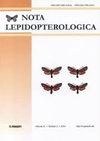Xenotorodor stygioxanthus gen. nov., sp. nov. (Lepidoptera, Lecithoceridae, Torodorinae), described from an established population in Spain with discussion of taxonomic placement
IF 0.7
4区 农林科学
Q4 ENTOMOLOGY
引用次数: 0
Abstract
The family Lecithoceridae is not well represented in the Palaearctic region, with very few taxa in Europe. Here we describe a new genus and species of lecithocerid moth, Xenotorodor stygioxanthus Sterling, Lees & Grundy, gen. nov. , sp. nov. The taxon represents a subfamily new to Europe. We consider placement of the genus within Crocanthinae or Torodorinae. We place it in Torodorinae, notwithstanding the reduced gnathos in the male genitalia. DNA barcodes suggest that the taxon belongs within a distal clade of this subfamily. They are over 9.2% pairwise divergent from any hitherto cleanly sequenced Lepidoptera taxon and over 10.1% from nearest taxonomically identified neighbours in Neighbor Joining and ML trees. Characteristics of the DNA barcode and morphology of this new taxon suggest that refinement of synapomorphies for the family and two subfamilies is needed. We have nearly 100 records for this new species since 2020, all from a small area of Southern Spain, close to the Straits of Gibraltar. The life history and early stages of the species are unknown.Xenotorodor stygioxanthus gen. nov., sp. nov.(鳞翅目,蠓科,蠓科),来自西班牙一个已建立种群的记述及其分类定位的讨论
蠓科在古北区分布较少,在欧洲分布较少。本文描述了一种新属(Xenotorodor stygioxanthus Sterling, Lees &Grundy, gen. 11 ., sp. 11 .这个分类群代表了欧洲新发现的一个亚科。我们考虑将该属置于Crocanthinae或Torodorinae中。我们把它归为鸟虻科,尽管在雄性生殖器上有缩小的牙颌。DNA条形码显示该分类单元属于该亚科的远端分支。它们与迄今为止已测序的鳞翅目分类群有超过9.2%的成对差异,与邻接树和ML树中最近的分类已确定的邻居有超过10.1%的成对差异。这一新分类单元的DNA条形码和形态特征表明,需要对该科和两个亚科的突触形态进行改进。自2020年以来,我们有近100条关于这种新物种的记录,全部来自西班牙南部靠近直布罗陀海峡的一小块地区。该物种的生活史和早期阶段尚不清楚。
本文章由计算机程序翻译,如有差异,请以英文原文为准。
求助全文
约1分钟内获得全文
求助全文
来源期刊

Nota Lepidopterologica
Agricultural and Biological Sciences-Insect Science
CiteScore
1.70
自引率
14.30%
发文量
20
审稿时长
14 weeks
期刊介绍:
Nota Lepidopterologica is the scientific, peer-reviewed journal of the Societas Europaea Lepidopterologica (SEL). It publishes original contributions to the study of mainly but not exclusively Palaearctic Lepidoptera, especially on taxonomy, morphology/anatomy, phylogenetics, biogeography, ecology, behaviour, and conservation, but also on any other aspects of lepidopterology.
All articles are published in English, with the possibility of having the summary written in other languages. All submitted manuscripts are subject to peer-review by the leading specialists for the respective topic. The journal is published in open access high-resolution PDF, semantically enriched HTML and machine-readable XML versions.
All papers can be freely copied, downloaded, printed and distributed at no charge. Authors and readers are thus encouraged to post the pdf files of published papers on homepages or elsewhere to expedite distribution. Publication is free for the SEL members and there is no charge for color.
 求助内容:
求助内容: 应助结果提醒方式:
应助结果提醒方式:


